Organizational Change: Leadership, Communication and Change Models
VerifiedAdded on 2022/08/18
|19
|4696
|17
Report
AI Summary
This report provides an in-depth analysis of organizational change, addressing key aspects such as stakeholder analysis, the role of communication in change management, and various change models. It examines the nature of resistance to change and strategies for overcoming it, along with the importance of ethical behavior in change management processes. The report uses the case study of Lakeland Wonders, illustrating how the CEO's approach to organizational change, including the implementation of new product lines, expansion of manufacturing activities, and changes in organizational culture, was received by different stakeholders and the impact of communication. It also highlights the importance of a transformational leadership style in facilitating successful change implementation, emphasizing the need for open communication, building trust, and considering employee perspectives to ensure the effective management of change. The report discusses the 8-step model of organizational change, providing a framework for understanding and managing change initiatives.
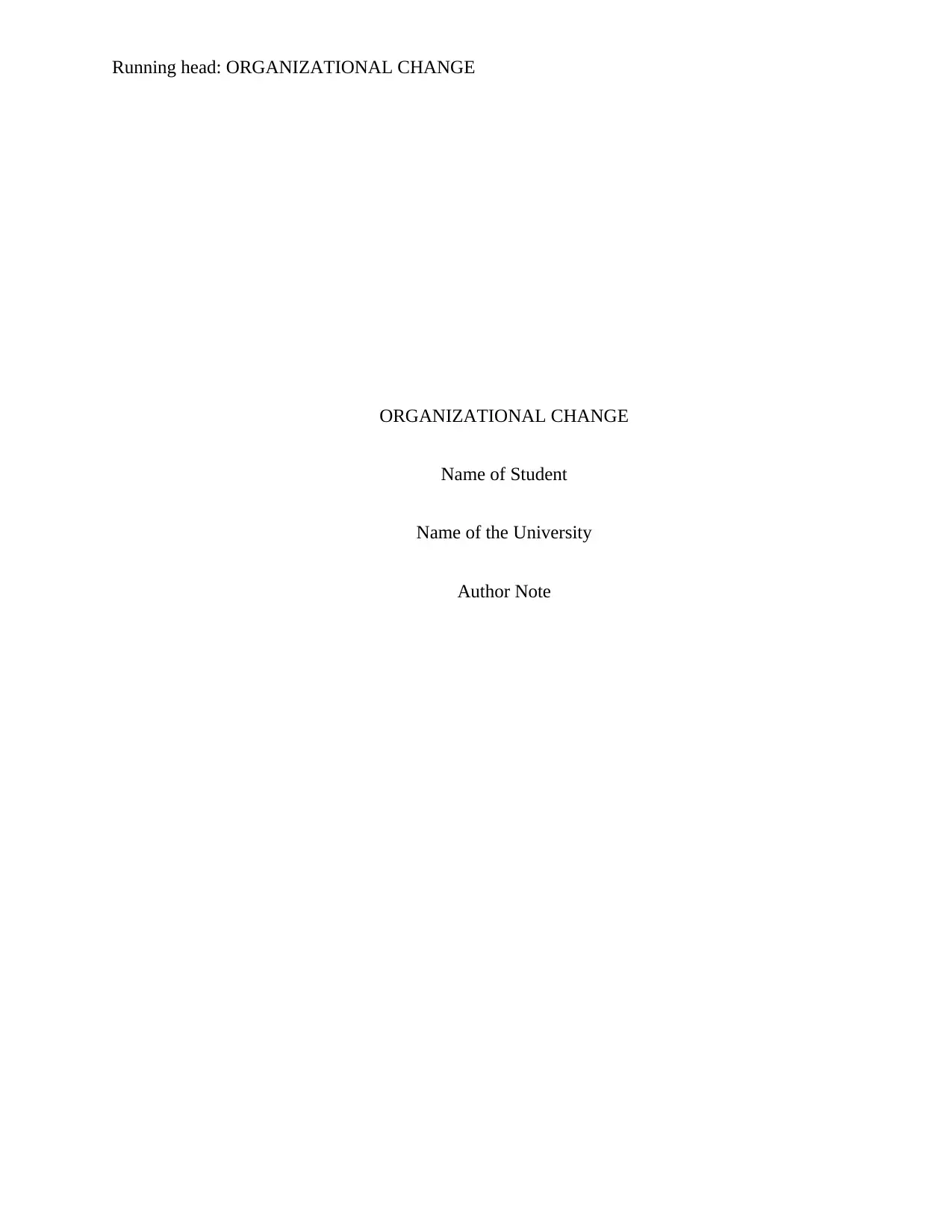
Running head: ORGANIZATIONAL CHANGE
ORGANIZATIONAL CHANGE
Name of Student
Name of the University
Author Note
ORGANIZATIONAL CHANGE
Name of Student
Name of the University
Author Note
Paraphrase This Document
Need a fresh take? Get an instant paraphrase of this document with our AI Paraphraser
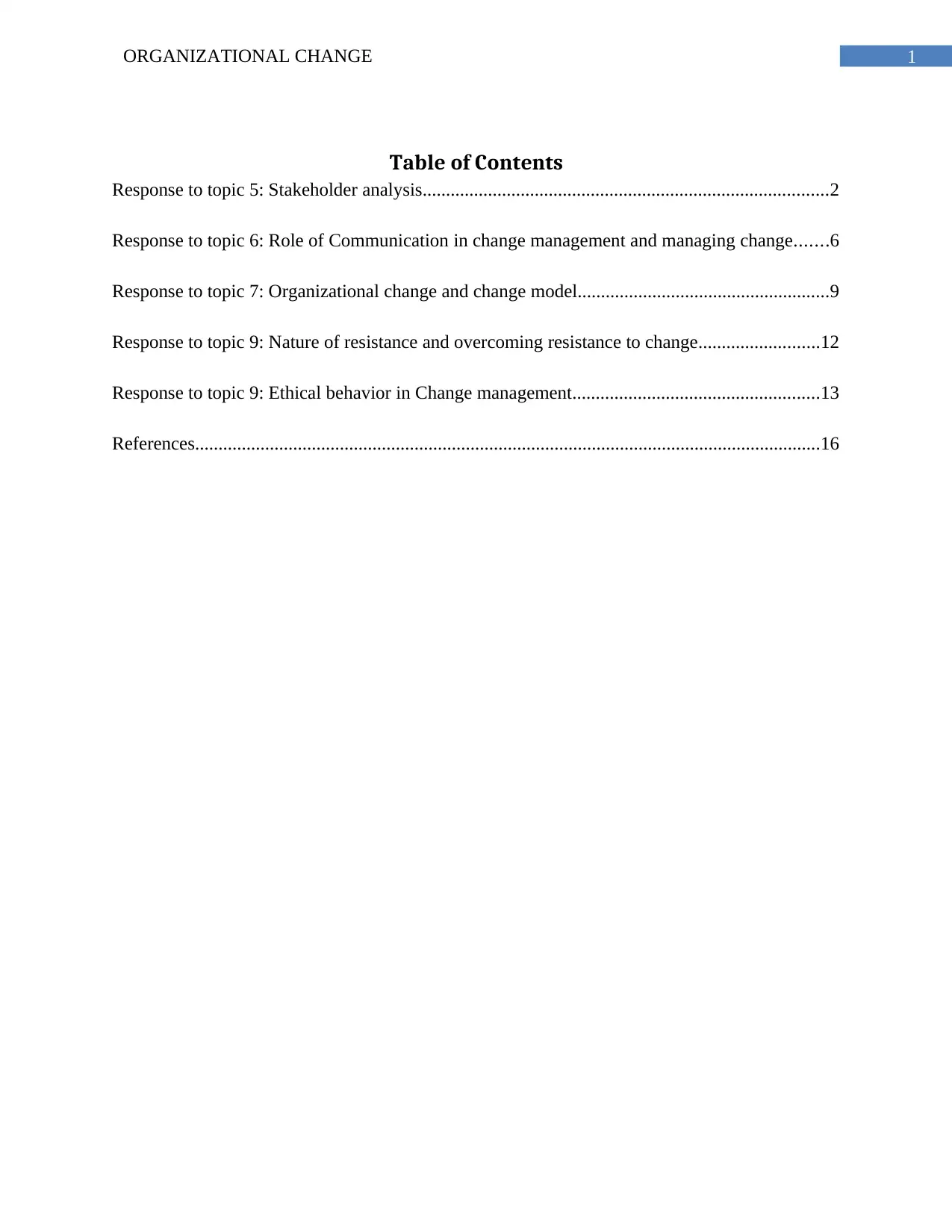
1ORGANIZATIONAL CHANGE
Table of Contents
Response to topic 5: Stakeholder analysis.......................................................................................2
Response to topic 6: Role of Communication in change management and managing change.......6
Response to topic 7: Organizational change and change model......................................................9
Response to topic 9: Nature of resistance and overcoming resistance to change..........................12
Response to topic 9: Ethical behavior in Change management.....................................................13
References......................................................................................................................................16
Table of Contents
Response to topic 5: Stakeholder analysis.......................................................................................2
Response to topic 6: Role of Communication in change management and managing change.......6
Response to topic 7: Organizational change and change model......................................................9
Response to topic 9: Nature of resistance and overcoming resistance to change..........................12
Response to topic 9: Ethical behavior in Change management.....................................................13
References......................................................................................................................................16
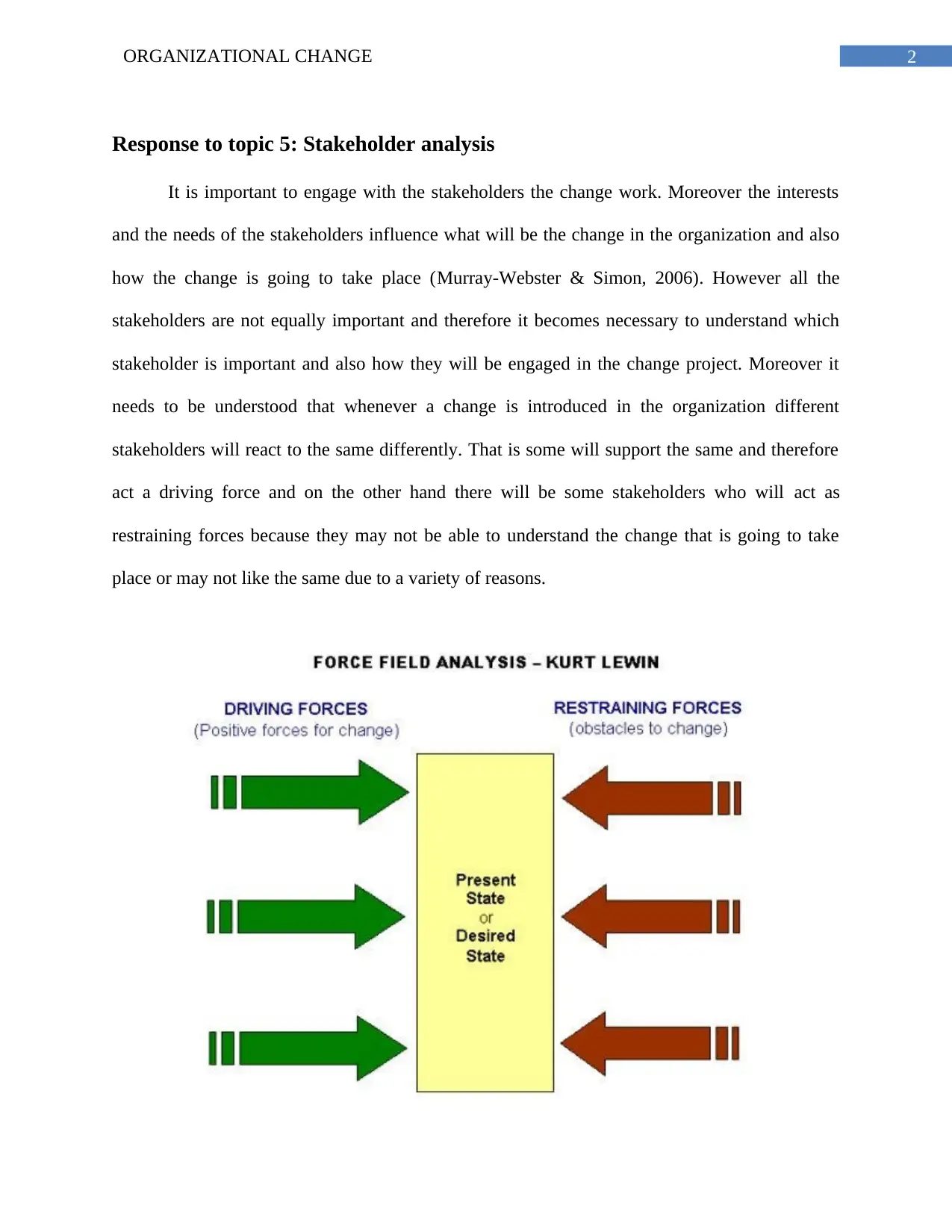
2ORGANIZATIONAL CHANGE
Response to topic 5: Stakeholder analysis
It is important to engage with the stakeholders the change work. Moreover the interests
and the needs of the stakeholders influence what will be the change in the organization and also
how the change is going to take place (Murray-Webster & Simon, 2006). However all the
stakeholders are not equally important and therefore it becomes necessary to understand which
stakeholder is important and also how they will be engaged in the change project. Moreover it
needs to be understood that whenever a change is introduced in the organization different
stakeholders will react to the same differently. That is some will support the same and therefore
act a driving force and on the other hand there will be some stakeholders who will act as
restraining forces because they may not be able to understand the change that is going to take
place or may not like the same due to a variety of reasons.
Response to topic 5: Stakeholder analysis
It is important to engage with the stakeholders the change work. Moreover the interests
and the needs of the stakeholders influence what will be the change in the organization and also
how the change is going to take place (Murray-Webster & Simon, 2006). However all the
stakeholders are not equally important and therefore it becomes necessary to understand which
stakeholder is important and also how they will be engaged in the change project. Moreover it
needs to be understood that whenever a change is introduced in the organization different
stakeholders will react to the same differently. That is some will support the same and therefore
act a driving force and on the other hand there will be some stakeholders who will act as
restraining forces because they may not be able to understand the change that is going to take
place or may not like the same due to a variety of reasons.
⊘ This is a preview!⊘
Do you want full access?
Subscribe today to unlock all pages.

Trusted by 1+ million students worldwide
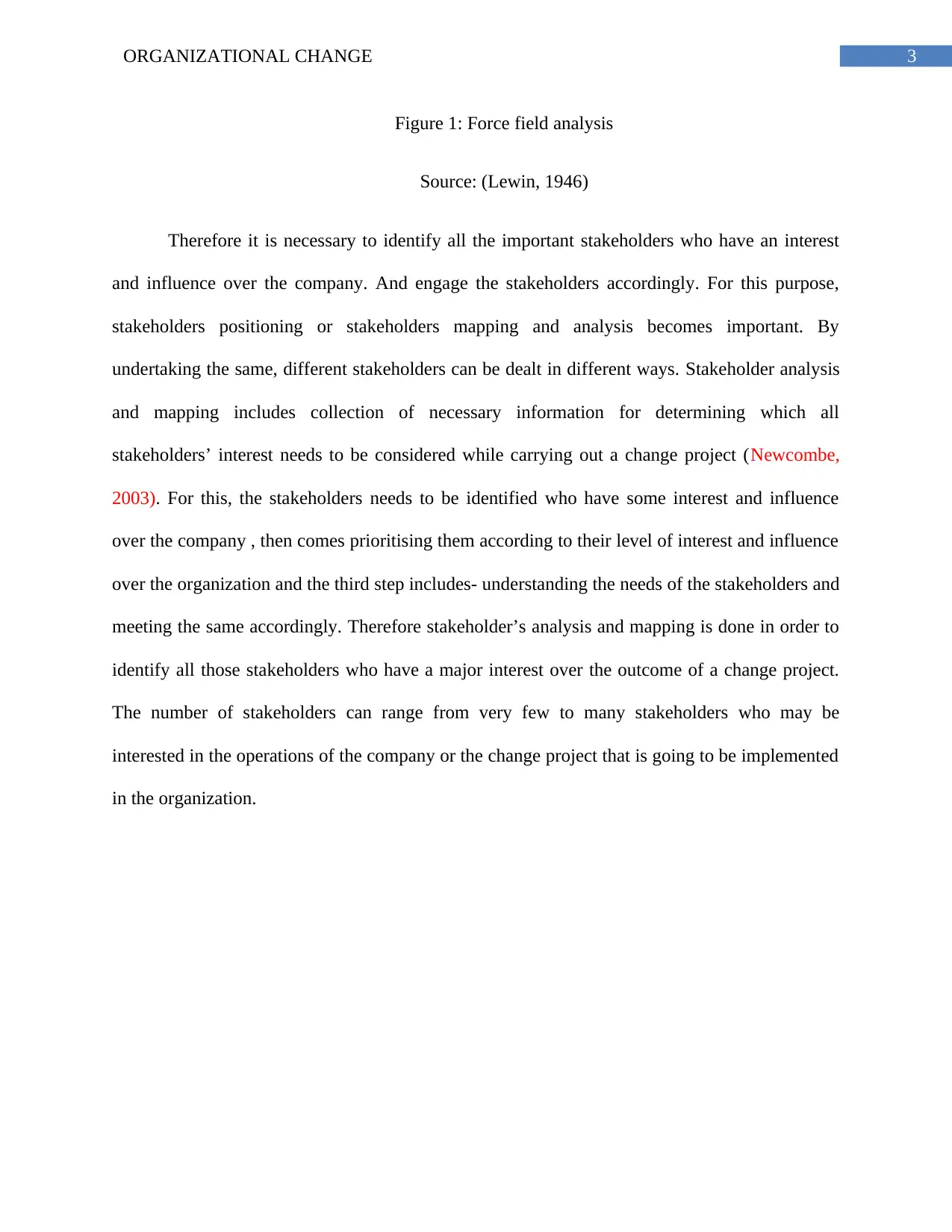
3ORGANIZATIONAL CHANGE
Figure 1: Force field analysis
Source: (Lewin, 1946)
Therefore it is necessary to identify all the important stakeholders who have an interest
and influence over the company. And engage the stakeholders accordingly. For this purpose,
stakeholders positioning or stakeholders mapping and analysis becomes important. By
undertaking the same, different stakeholders can be dealt in different ways. Stakeholder analysis
and mapping includes collection of necessary information for determining which all
stakeholders’ interest needs to be considered while carrying out a change project (Newcombe,
2003). For this, the stakeholders needs to be identified who have some interest and influence
over the company , then comes prioritising them according to their level of interest and influence
over the organization and the third step includes- understanding the needs of the stakeholders and
meeting the same accordingly. Therefore stakeholder’s analysis and mapping is done in order to
identify all those stakeholders who have a major interest over the outcome of a change project.
The number of stakeholders can range from very few to many stakeholders who may be
interested in the operations of the company or the change project that is going to be implemented
in the organization.
Figure 1: Force field analysis
Source: (Lewin, 1946)
Therefore it is necessary to identify all the important stakeholders who have an interest
and influence over the company. And engage the stakeholders accordingly. For this purpose,
stakeholders positioning or stakeholders mapping and analysis becomes important. By
undertaking the same, different stakeholders can be dealt in different ways. Stakeholder analysis
and mapping includes collection of necessary information for determining which all
stakeholders’ interest needs to be considered while carrying out a change project (Newcombe,
2003). For this, the stakeholders needs to be identified who have some interest and influence
over the company , then comes prioritising them according to their level of interest and influence
over the organization and the third step includes- understanding the needs of the stakeholders and
meeting the same accordingly. Therefore stakeholder’s analysis and mapping is done in order to
identify all those stakeholders who have a major interest over the outcome of a change project.
The number of stakeholders can range from very few to many stakeholders who may be
interested in the operations of the company or the change project that is going to be implemented
in the organization.
Paraphrase This Document
Need a fresh take? Get an instant paraphrase of this document with our AI Paraphraser
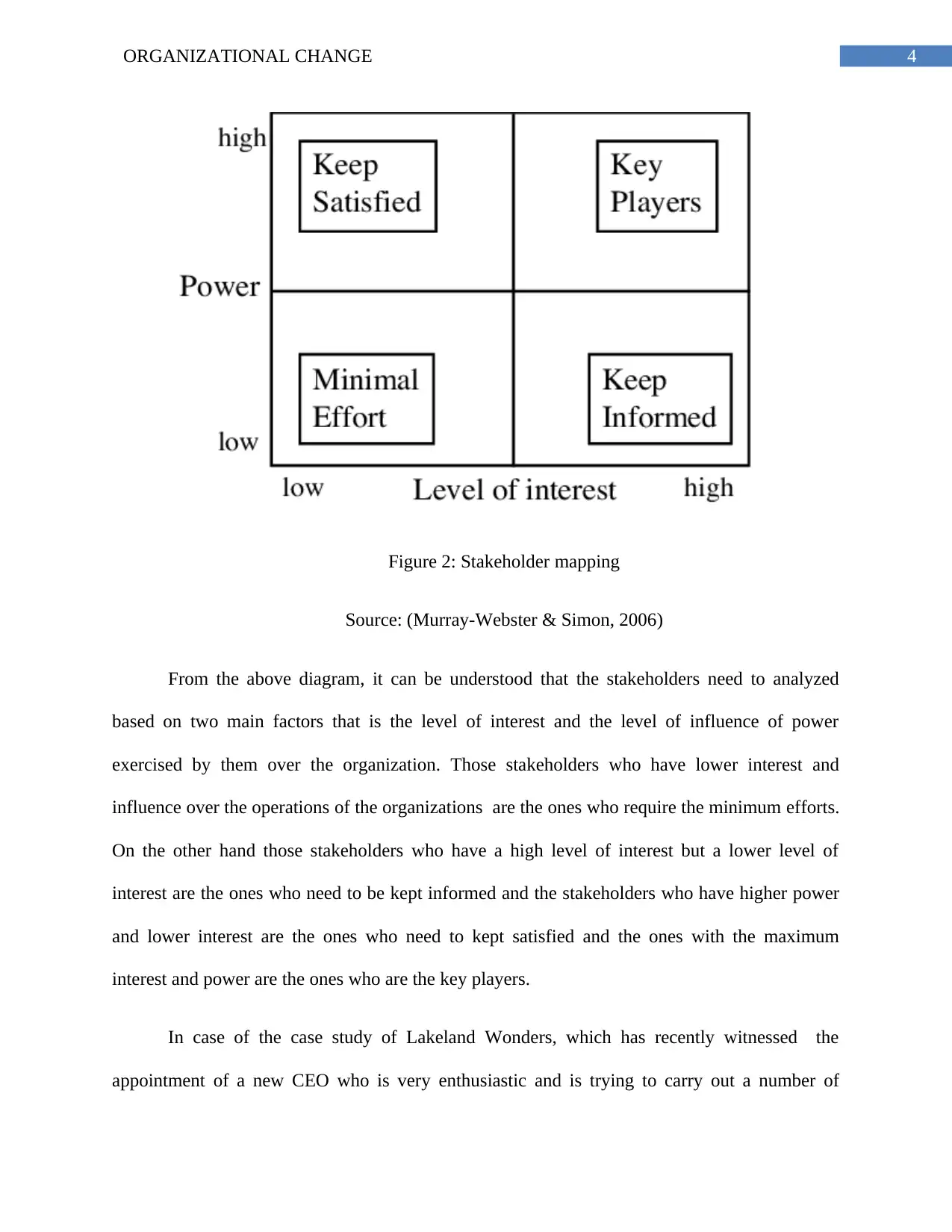
4ORGANIZATIONAL CHANGE
Figure 2: Stakeholder mapping
Source: (Murray-Webster & Simon, 2006)
From the above diagram, it can be understood that the stakeholders need to analyzed
based on two main factors that is the level of interest and the level of influence of power
exercised by them over the organization. Those stakeholders who have lower interest and
influence over the operations of the organizations are the ones who require the minimum efforts.
On the other hand those stakeholders who have a high level of interest but a lower level of
interest are the ones who need to be kept informed and the stakeholders who have higher power
and lower interest are the ones who need to kept satisfied and the ones with the maximum
interest and power are the ones who are the key players.
In case of the case study of Lakeland Wonders, which has recently witnessed the
appointment of a new CEO who is very enthusiastic and is trying to carry out a number of
Figure 2: Stakeholder mapping
Source: (Murray-Webster & Simon, 2006)
From the above diagram, it can be understood that the stakeholders need to analyzed
based on two main factors that is the level of interest and the level of influence of power
exercised by them over the organization. Those stakeholders who have lower interest and
influence over the operations of the organizations are the ones who require the minimum efforts.
On the other hand those stakeholders who have a high level of interest but a lower level of
interest are the ones who need to be kept informed and the stakeholders who have higher power
and lower interest are the ones who need to kept satisfied and the ones with the maximum
interest and power are the ones who are the key players.
In case of the case study of Lakeland Wonders, which has recently witnessed the
appointment of a new CEO who is very enthusiastic and is trying to carry out a number of
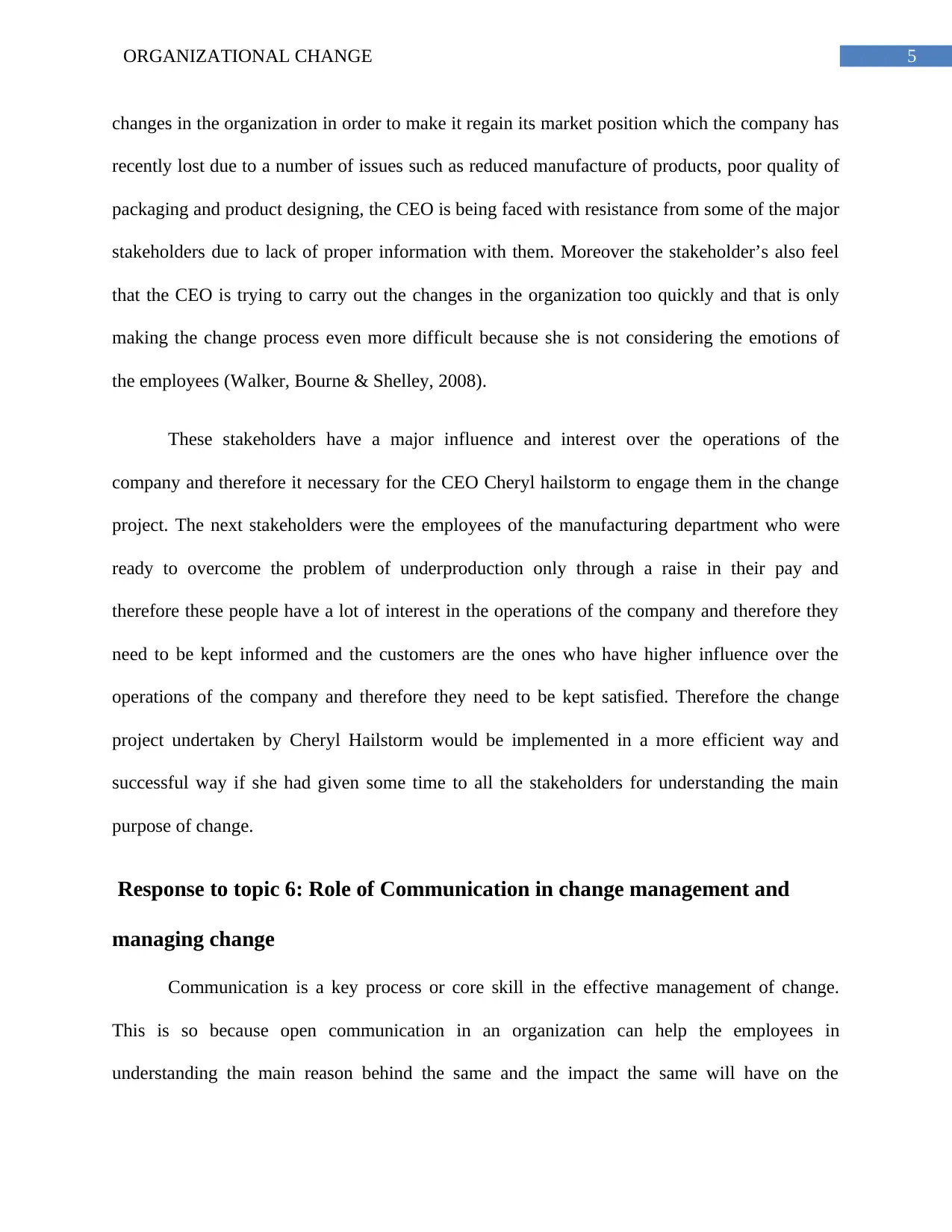
5ORGANIZATIONAL CHANGE
changes in the organization in order to make it regain its market position which the company has
recently lost due to a number of issues such as reduced manufacture of products, poor quality of
packaging and product designing, the CEO is being faced with resistance from some of the major
stakeholders due to lack of proper information with them. Moreover the stakeholder’s also feel
that the CEO is trying to carry out the changes in the organization too quickly and that is only
making the change process even more difficult because she is not considering the emotions of
the employees (Walker, Bourne & Shelley, 2008).
These stakeholders have a major influence and interest over the operations of the
company and therefore it necessary for the CEO Cheryl hailstorm to engage them in the change
project. The next stakeholders were the employees of the manufacturing department who were
ready to overcome the problem of underproduction only through a raise in their pay and
therefore these people have a lot of interest in the operations of the company and therefore they
need to be kept informed and the customers are the ones who have higher influence over the
operations of the company and therefore they need to be kept satisfied. Therefore the change
project undertaken by Cheryl Hailstorm would be implemented in a more efficient way and
successful way if she had given some time to all the stakeholders for understanding the main
purpose of change.
Response to topic 6: Role of Communication in change management and
managing change
Communication is a key process or core skill in the effective management of change.
This is so because open communication in an organization can help the employees in
understanding the main reason behind the same and the impact the same will have on the
changes in the organization in order to make it regain its market position which the company has
recently lost due to a number of issues such as reduced manufacture of products, poor quality of
packaging and product designing, the CEO is being faced with resistance from some of the major
stakeholders due to lack of proper information with them. Moreover the stakeholder’s also feel
that the CEO is trying to carry out the changes in the organization too quickly and that is only
making the change process even more difficult because she is not considering the emotions of
the employees (Walker, Bourne & Shelley, 2008).
These stakeholders have a major influence and interest over the operations of the
company and therefore it necessary for the CEO Cheryl hailstorm to engage them in the change
project. The next stakeholders were the employees of the manufacturing department who were
ready to overcome the problem of underproduction only through a raise in their pay and
therefore these people have a lot of interest in the operations of the company and therefore they
need to be kept informed and the customers are the ones who have higher influence over the
operations of the company and therefore they need to be kept satisfied. Therefore the change
project undertaken by Cheryl Hailstorm would be implemented in a more efficient way and
successful way if she had given some time to all the stakeholders for understanding the main
purpose of change.
Response to topic 6: Role of Communication in change management and
managing change
Communication is a key process or core skill in the effective management of change.
This is so because open communication in an organization can help the employees in
understanding the main reason behind the same and the impact the same will have on the
⊘ This is a preview!⊘
Do you want full access?
Subscribe today to unlock all pages.

Trusted by 1+ million students worldwide
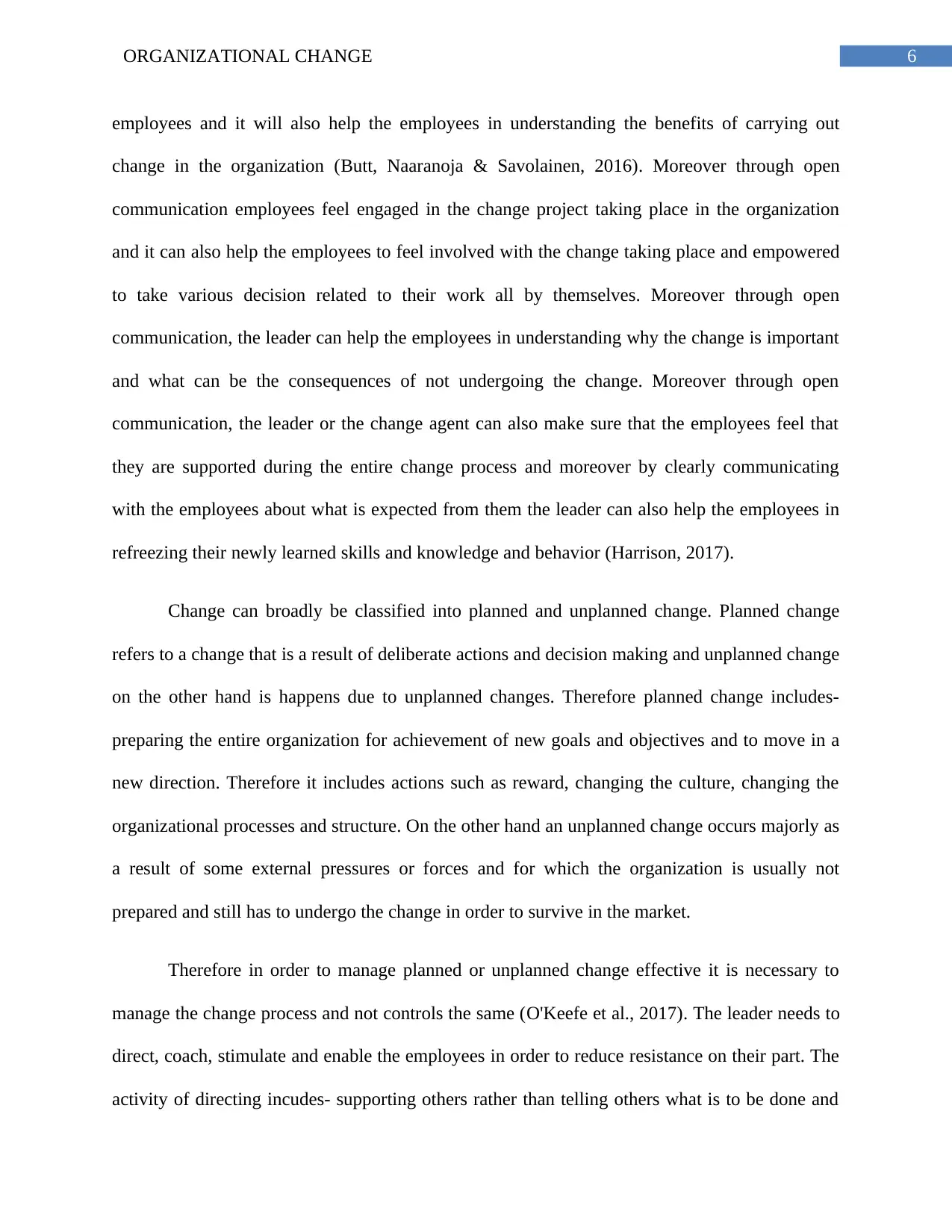
6ORGANIZATIONAL CHANGE
employees and it will also help the employees in understanding the benefits of carrying out
change in the organization (Butt, Naaranoja & Savolainen, 2016). Moreover through open
communication employees feel engaged in the change project taking place in the organization
and it can also help the employees to feel involved with the change taking place and empowered
to take various decision related to their work all by themselves. Moreover through open
communication, the leader can help the employees in understanding why the change is important
and what can be the consequences of not undergoing the change. Moreover through open
communication, the leader or the change agent can also make sure that the employees feel that
they are supported during the entire change process and moreover by clearly communicating
with the employees about what is expected from them the leader can also help the employees in
refreezing their newly learned skills and knowledge and behavior (Harrison, 2017).
Change can broadly be classified into planned and unplanned change. Planned change
refers to a change that is a result of deliberate actions and decision making and unplanned change
on the other hand is happens due to unplanned changes. Therefore planned change includes-
preparing the entire organization for achievement of new goals and objectives and to move in a
new direction. Therefore it includes actions such as reward, changing the culture, changing the
organizational processes and structure. On the other hand an unplanned change occurs majorly as
a result of some external pressures or forces and for which the organization is usually not
prepared and still has to undergo the change in order to survive in the market.
Therefore in order to manage planned or unplanned change effective it is necessary to
manage the change process and not controls the same (O'Keefe et al., 2017). The leader needs to
direct, coach, stimulate and enable the employees in order to reduce resistance on their part. The
activity of directing incudes- supporting others rather than telling others what is to be done and
employees and it will also help the employees in understanding the benefits of carrying out
change in the organization (Butt, Naaranoja & Savolainen, 2016). Moreover through open
communication employees feel engaged in the change project taking place in the organization
and it can also help the employees to feel involved with the change taking place and empowered
to take various decision related to their work all by themselves. Moreover through open
communication, the leader can help the employees in understanding why the change is important
and what can be the consequences of not undergoing the change. Moreover through open
communication, the leader or the change agent can also make sure that the employees feel that
they are supported during the entire change process and moreover by clearly communicating
with the employees about what is expected from them the leader can also help the employees in
refreezing their newly learned skills and knowledge and behavior (Harrison, 2017).
Change can broadly be classified into planned and unplanned change. Planned change
refers to a change that is a result of deliberate actions and decision making and unplanned change
on the other hand is happens due to unplanned changes. Therefore planned change includes-
preparing the entire organization for achievement of new goals and objectives and to move in a
new direction. Therefore it includes actions such as reward, changing the culture, changing the
organizational processes and structure. On the other hand an unplanned change occurs majorly as
a result of some external pressures or forces and for which the organization is usually not
prepared and still has to undergo the change in order to survive in the market.
Therefore in order to manage planned or unplanned change effective it is necessary to
manage the change process and not controls the same (O'Keefe et al., 2017). The leader needs to
direct, coach, stimulate and enable the employees in order to reduce resistance on their part. The
activity of directing incudes- supporting others rather than telling others what is to be done and
Paraphrase This Document
Need a fresh take? Get an instant paraphrase of this document with our AI Paraphraser
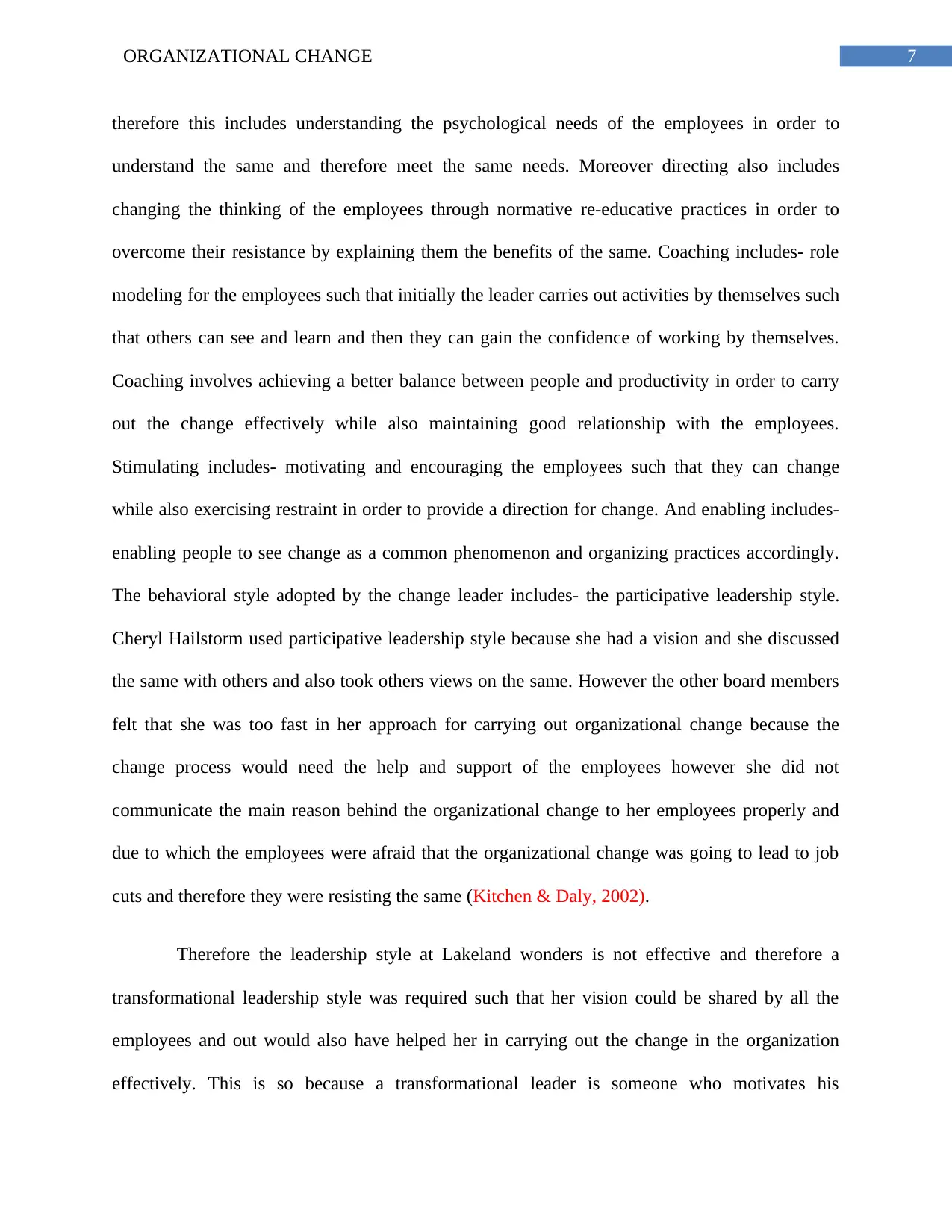
7ORGANIZATIONAL CHANGE
therefore this includes understanding the psychological needs of the employees in order to
understand the same and therefore meet the same needs. Moreover directing also includes
changing the thinking of the employees through normative re-educative practices in order to
overcome their resistance by explaining them the benefits of the same. Coaching includes- role
modeling for the employees such that initially the leader carries out activities by themselves such
that others can see and learn and then they can gain the confidence of working by themselves.
Coaching involves achieving a better balance between people and productivity in order to carry
out the change effectively while also maintaining good relationship with the employees.
Stimulating includes- motivating and encouraging the employees such that they can change
while also exercising restraint in order to provide a direction for change. And enabling includes-
enabling people to see change as a common phenomenon and organizing practices accordingly.
The behavioral style adopted by the change leader includes- the participative leadership style.
Cheryl Hailstorm used participative leadership style because she had a vision and she discussed
the same with others and also took others views on the same. However the other board members
felt that she was too fast in her approach for carrying out organizational change because the
change process would need the help and support of the employees however she did not
communicate the main reason behind the organizational change to her employees properly and
due to which the employees were afraid that the organizational change was going to lead to job
cuts and therefore they were resisting the same (Kitchen & Daly, 2002).
Therefore the leadership style at Lakeland wonders is not effective and therefore a
transformational leadership style was required such that her vision could be shared by all the
employees and out would also have helped her in carrying out the change in the organization
effectively. This is so because a transformational leader is someone who motivates his
therefore this includes understanding the psychological needs of the employees in order to
understand the same and therefore meet the same needs. Moreover directing also includes
changing the thinking of the employees through normative re-educative practices in order to
overcome their resistance by explaining them the benefits of the same. Coaching includes- role
modeling for the employees such that initially the leader carries out activities by themselves such
that others can see and learn and then they can gain the confidence of working by themselves.
Coaching involves achieving a better balance between people and productivity in order to carry
out the change effectively while also maintaining good relationship with the employees.
Stimulating includes- motivating and encouraging the employees such that they can change
while also exercising restraint in order to provide a direction for change. And enabling includes-
enabling people to see change as a common phenomenon and organizing practices accordingly.
The behavioral style adopted by the change leader includes- the participative leadership style.
Cheryl Hailstorm used participative leadership style because she had a vision and she discussed
the same with others and also took others views on the same. However the other board members
felt that she was too fast in her approach for carrying out organizational change because the
change process would need the help and support of the employees however she did not
communicate the main reason behind the organizational change to her employees properly and
due to which the employees were afraid that the organizational change was going to lead to job
cuts and therefore they were resisting the same (Kitchen & Daly, 2002).
Therefore the leadership style at Lakeland wonders is not effective and therefore a
transformational leadership style was required such that her vision could be shared by all the
employees and out would also have helped her in carrying out the change in the organization
effectively. This is so because a transformational leader is someone who motivates his
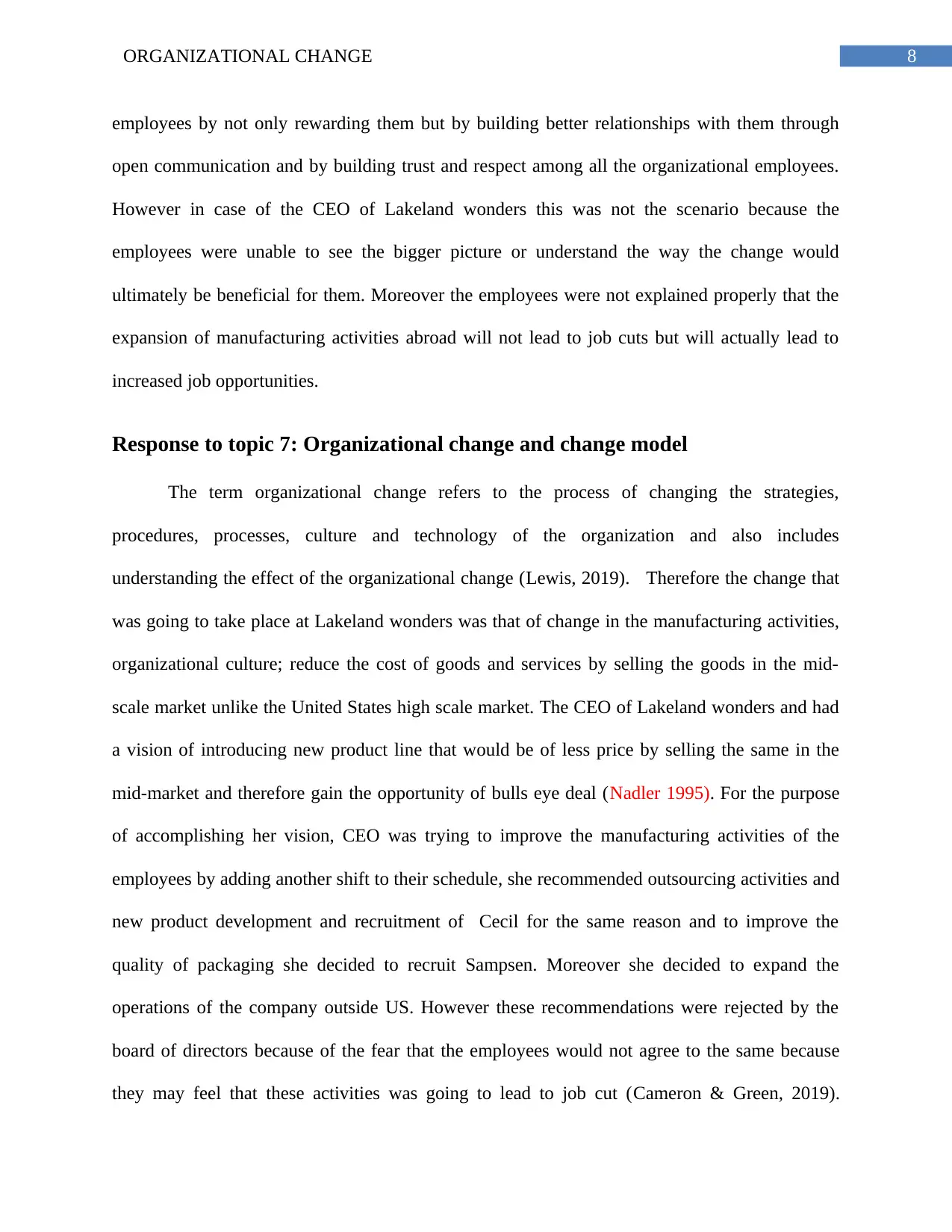
8ORGANIZATIONAL CHANGE
employees by not only rewarding them but by building better relationships with them through
open communication and by building trust and respect among all the organizational employees.
However in case of the CEO of Lakeland wonders this was not the scenario because the
employees were unable to see the bigger picture or understand the way the change would
ultimately be beneficial for them. Moreover the employees were not explained properly that the
expansion of manufacturing activities abroad will not lead to job cuts but will actually lead to
increased job opportunities.
Response to topic 7: Organizational change and change model
The term organizational change refers to the process of changing the strategies,
procedures, processes, culture and technology of the organization and also includes
understanding the effect of the organizational change (Lewis, 2019). Therefore the change that
was going to take place at Lakeland wonders was that of change in the manufacturing activities,
organizational culture; reduce the cost of goods and services by selling the goods in the mid-
scale market unlike the United States high scale market. The CEO of Lakeland wonders and had
a vision of introducing new product line that would be of less price by selling the same in the
mid-market and therefore gain the opportunity of bulls eye deal (Nadler 1995). For the purpose
of accomplishing her vision, CEO was trying to improve the manufacturing activities of the
employees by adding another shift to their schedule, she recommended outsourcing activities and
new product development and recruitment of Cecil for the same reason and to improve the
quality of packaging she decided to recruit Sampsen. Moreover she decided to expand the
operations of the company outside US. However these recommendations were rejected by the
board of directors because of the fear that the employees would not agree to the same because
they may feel that these activities was going to lead to job cut (Cameron & Green, 2019).
employees by not only rewarding them but by building better relationships with them through
open communication and by building trust and respect among all the organizational employees.
However in case of the CEO of Lakeland wonders this was not the scenario because the
employees were unable to see the bigger picture or understand the way the change would
ultimately be beneficial for them. Moreover the employees were not explained properly that the
expansion of manufacturing activities abroad will not lead to job cuts but will actually lead to
increased job opportunities.
Response to topic 7: Organizational change and change model
The term organizational change refers to the process of changing the strategies,
procedures, processes, culture and technology of the organization and also includes
understanding the effect of the organizational change (Lewis, 2019). Therefore the change that
was going to take place at Lakeland wonders was that of change in the manufacturing activities,
organizational culture; reduce the cost of goods and services by selling the goods in the mid-
scale market unlike the United States high scale market. The CEO of Lakeland wonders and had
a vision of introducing new product line that would be of less price by selling the same in the
mid-market and therefore gain the opportunity of bulls eye deal (Nadler 1995). For the purpose
of accomplishing her vision, CEO was trying to improve the manufacturing activities of the
employees by adding another shift to their schedule, she recommended outsourcing activities and
new product development and recruitment of Cecil for the same reason and to improve the
quality of packaging she decided to recruit Sampsen. Moreover she decided to expand the
operations of the company outside US. However these recommendations were rejected by the
board of directors because of the fear that the employees would not agree to the same because
they may feel that these activities was going to lead to job cut (Cameron & Green, 2019).
⊘ This is a preview!⊘
Do you want full access?
Subscribe today to unlock all pages.

Trusted by 1+ million students worldwide
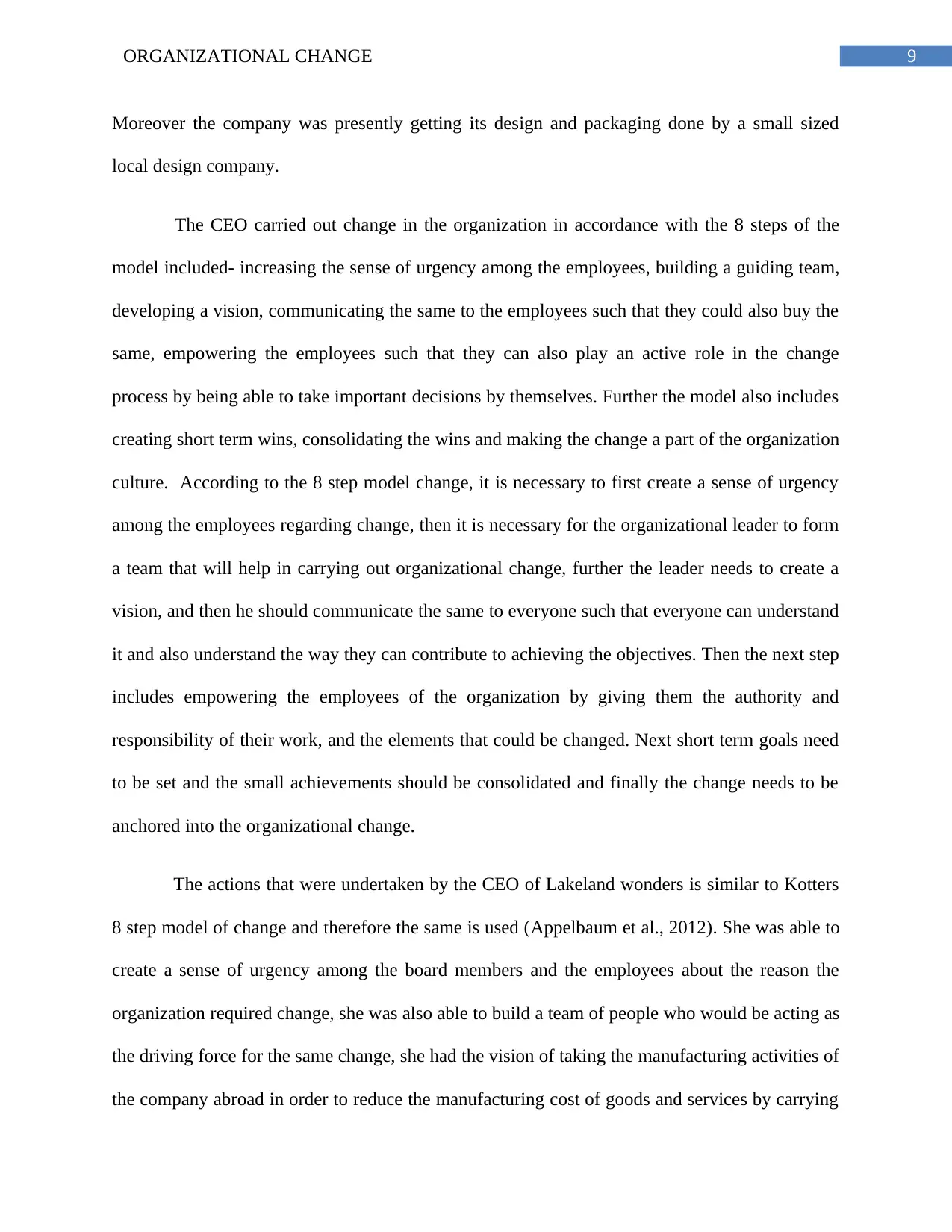
9ORGANIZATIONAL CHANGE
Moreover the company was presently getting its design and packaging done by a small sized
local design company.
The CEO carried out change in the organization in accordance with the 8 steps of the
model included- increasing the sense of urgency among the employees, building a guiding team,
developing a vision, communicating the same to the employees such that they could also buy the
same, empowering the employees such that they can also play an active role in the change
process by being able to take important decisions by themselves. Further the model also includes
creating short term wins, consolidating the wins and making the change a part of the organization
culture. According to the 8 step model change, it is necessary to first create a sense of urgency
among the employees regarding change, then it is necessary for the organizational leader to form
a team that will help in carrying out organizational change, further the leader needs to create a
vision, and then he should communicate the same to everyone such that everyone can understand
it and also understand the way they can contribute to achieving the objectives. Then the next step
includes empowering the employees of the organization by giving them the authority and
responsibility of their work, and the elements that could be changed. Next short term goals need
to be set and the small achievements should be consolidated and finally the change needs to be
anchored into the organizational change.
The actions that were undertaken by the CEO of Lakeland wonders is similar to Kotters
8 step model of change and therefore the same is used (Appelbaum et al., 2012). She was able to
create a sense of urgency among the board members and the employees about the reason the
organization required change, she was also able to build a team of people who would be acting as
the driving force for the same change, she had the vision of taking the manufacturing activities of
the company abroad in order to reduce the manufacturing cost of goods and services by carrying
Moreover the company was presently getting its design and packaging done by a small sized
local design company.
The CEO carried out change in the organization in accordance with the 8 steps of the
model included- increasing the sense of urgency among the employees, building a guiding team,
developing a vision, communicating the same to the employees such that they could also buy the
same, empowering the employees such that they can also play an active role in the change
process by being able to take important decisions by themselves. Further the model also includes
creating short term wins, consolidating the wins and making the change a part of the organization
culture. According to the 8 step model change, it is necessary to first create a sense of urgency
among the employees regarding change, then it is necessary for the organizational leader to form
a team that will help in carrying out organizational change, further the leader needs to create a
vision, and then he should communicate the same to everyone such that everyone can understand
it and also understand the way they can contribute to achieving the objectives. Then the next step
includes empowering the employees of the organization by giving them the authority and
responsibility of their work, and the elements that could be changed. Next short term goals need
to be set and the small achievements should be consolidated and finally the change needs to be
anchored into the organizational change.
The actions that were undertaken by the CEO of Lakeland wonders is similar to Kotters
8 step model of change and therefore the same is used (Appelbaum et al., 2012). She was able to
create a sense of urgency among the board members and the employees about the reason the
organization required change, she was also able to build a team of people who would be acting as
the driving force for the same change, she had the vision of taking the manufacturing activities of
the company abroad in order to reduce the manufacturing cost of goods and services by carrying
Paraphrase This Document
Need a fresh take? Get an instant paraphrase of this document with our AI Paraphraser
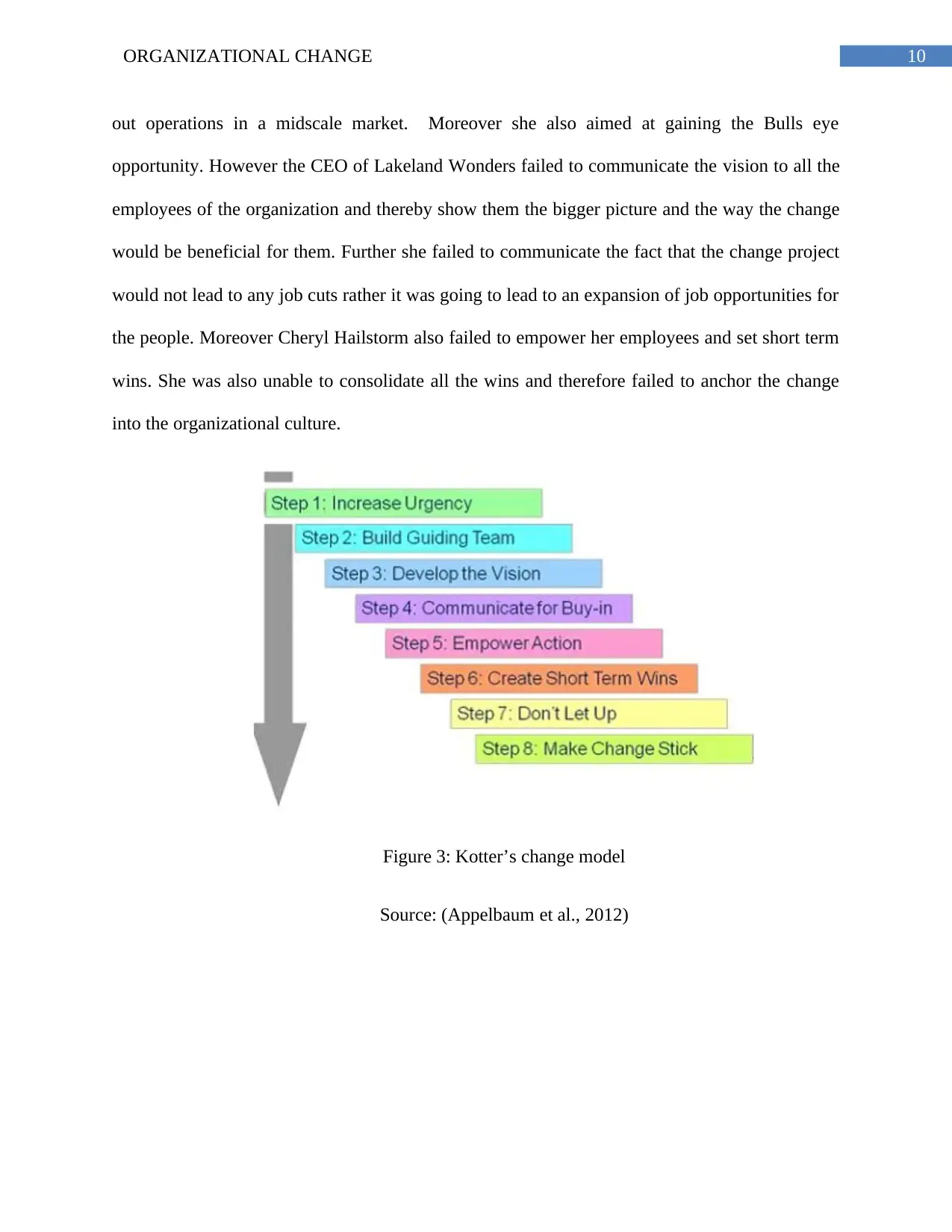
10ORGANIZATIONAL CHANGE
out operations in a midscale market. Moreover she also aimed at gaining the Bulls eye
opportunity. However the CEO of Lakeland Wonders failed to communicate the vision to all the
employees of the organization and thereby show them the bigger picture and the way the change
would be beneficial for them. Further she failed to communicate the fact that the change project
would not lead to any job cuts rather it was going to lead to an expansion of job opportunities for
the people. Moreover Cheryl Hailstorm also failed to empower her employees and set short term
wins. She was also unable to consolidate all the wins and therefore failed to anchor the change
into the organizational culture.
Figure 3: Kotter’s change model
Source: (Appelbaum et al., 2012)
out operations in a midscale market. Moreover she also aimed at gaining the Bulls eye
opportunity. However the CEO of Lakeland Wonders failed to communicate the vision to all the
employees of the organization and thereby show them the bigger picture and the way the change
would be beneficial for them. Further she failed to communicate the fact that the change project
would not lead to any job cuts rather it was going to lead to an expansion of job opportunities for
the people. Moreover Cheryl Hailstorm also failed to empower her employees and set short term
wins. She was also unable to consolidate all the wins and therefore failed to anchor the change
into the organizational culture.
Figure 3: Kotter’s change model
Source: (Appelbaum et al., 2012)
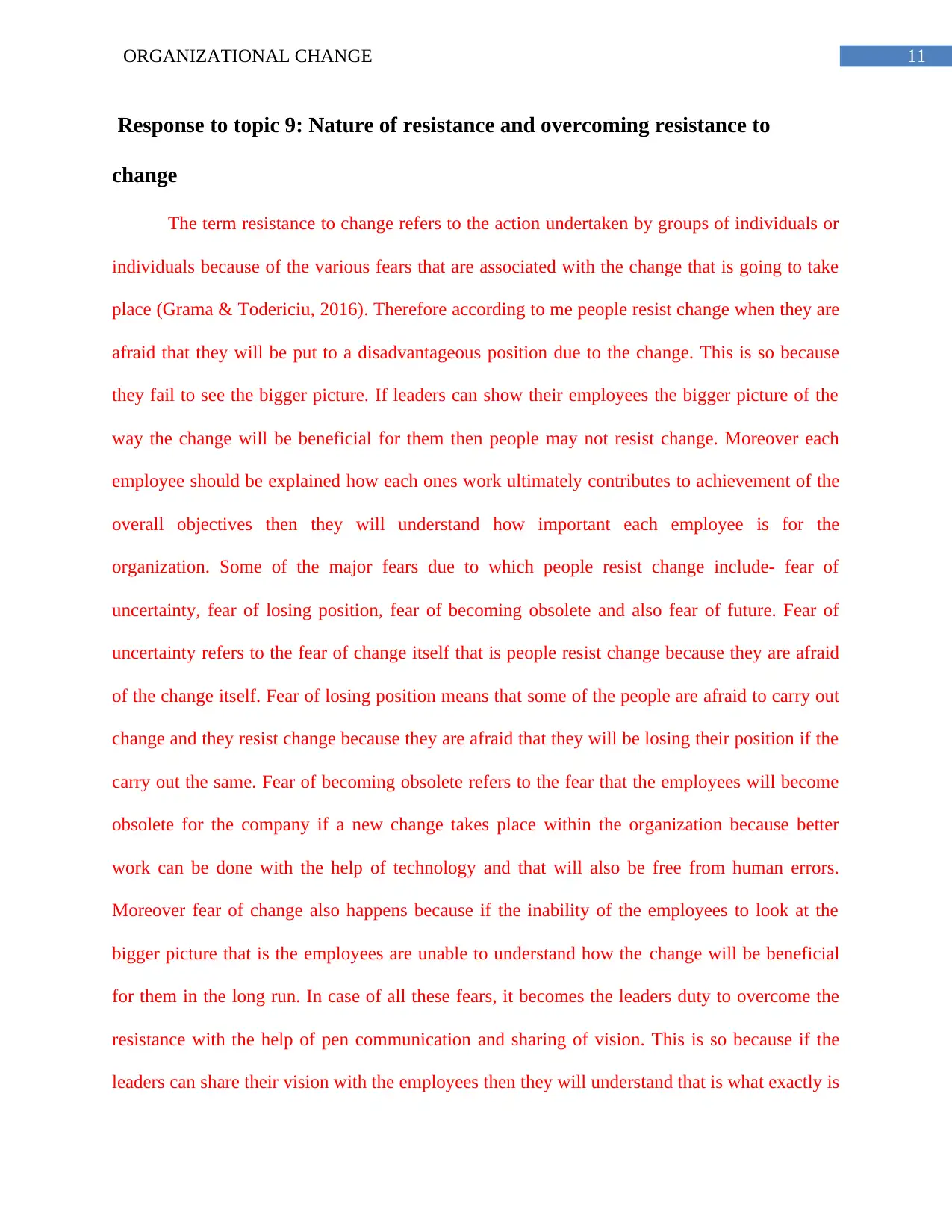
11ORGANIZATIONAL CHANGE
Response to topic 9: Nature of resistance and overcoming resistance to
change
The term resistance to change refers to the action undertaken by groups of individuals or
individuals because of the various fears that are associated with the change that is going to take
place (Grama & Todericiu, 2016). Therefore according to me people resist change when they are
afraid that they will be put to a disadvantageous position due to the change. This is so because
they fail to see the bigger picture. If leaders can show their employees the bigger picture of the
way the change will be beneficial for them then people may not resist change. Moreover each
employee should be explained how each ones work ultimately contributes to achievement of the
overall objectives then they will understand how important each employee is for the
organization. Some of the major fears due to which people resist change include- fear of
uncertainty, fear of losing position, fear of becoming obsolete and also fear of future. Fear of
uncertainty refers to the fear of change itself that is people resist change because they are afraid
of the change itself. Fear of losing position means that some of the people are afraid to carry out
change and they resist change because they are afraid that they will be losing their position if the
carry out the same. Fear of becoming obsolete refers to the fear that the employees will become
obsolete for the company if a new change takes place within the organization because better
work can be done with the help of technology and that will also be free from human errors.
Moreover fear of change also happens because if the inability of the employees to look at the
bigger picture that is the employees are unable to understand how the change will be beneficial
for them in the long run. In case of all these fears, it becomes the leaders duty to overcome the
resistance with the help of pen communication and sharing of vision. This is so because if the
leaders can share their vision with the employees then they will understand that is what exactly is
Response to topic 9: Nature of resistance and overcoming resistance to
change
The term resistance to change refers to the action undertaken by groups of individuals or
individuals because of the various fears that are associated with the change that is going to take
place (Grama & Todericiu, 2016). Therefore according to me people resist change when they are
afraid that they will be put to a disadvantageous position due to the change. This is so because
they fail to see the bigger picture. If leaders can show their employees the bigger picture of the
way the change will be beneficial for them then people may not resist change. Moreover each
employee should be explained how each ones work ultimately contributes to achievement of the
overall objectives then they will understand how important each employee is for the
organization. Some of the major fears due to which people resist change include- fear of
uncertainty, fear of losing position, fear of becoming obsolete and also fear of future. Fear of
uncertainty refers to the fear of change itself that is people resist change because they are afraid
of the change itself. Fear of losing position means that some of the people are afraid to carry out
change and they resist change because they are afraid that they will be losing their position if the
carry out the same. Fear of becoming obsolete refers to the fear that the employees will become
obsolete for the company if a new change takes place within the organization because better
work can be done with the help of technology and that will also be free from human errors.
Moreover fear of change also happens because if the inability of the employees to look at the
bigger picture that is the employees are unable to understand how the change will be beneficial
for them in the long run. In case of all these fears, it becomes the leaders duty to overcome the
resistance with the help of pen communication and sharing of vision. This is so because if the
leaders can share their vision with the employees then they will understand that is what exactly is
⊘ This is a preview!⊘
Do you want full access?
Subscribe today to unlock all pages.

Trusted by 1+ million students worldwide
1 out of 19
Related Documents
Your All-in-One AI-Powered Toolkit for Academic Success.
+13062052269
info@desklib.com
Available 24*7 on WhatsApp / Email
![[object Object]](/_next/static/media/star-bottom.7253800d.svg)
Unlock your academic potential
Copyright © 2020–2025 A2Z Services. All Rights Reserved. Developed and managed by ZUCOL.





